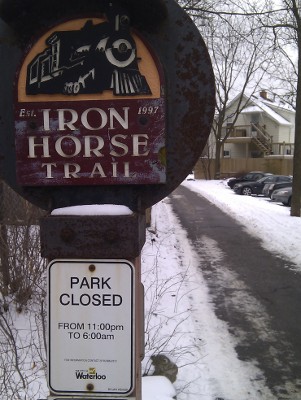Safety on the Iron Horse Trail
 How many streets do you know that close at night?
How many streets do you know that close at night?
The recent murder on the Iron Horse Trail has sparked public discussion of trail safety and how to improve it. While suspects have been apprehended, the safety of the trail remains an important issue, particularly as the attack appears not to have been targeted. Whether or not the trail is actually as dangerous as often portrayed, there is a strong feeling in the community that one shouldn’t use the trail when it’s dark, and that’s unacceptable for such a major transportation link.
Many people have suggested that the trail should be lit at night, which is an obvious thing to do and which should have been done long ago. Most know that the Iron Horse Trail used to be a former railway, but it also used to an electric railway. So if you look carefully along the entire length of the IHT, you’ll actually find hydro poles going all the way along. Adding lighting should not be a difficult proposition.
Why is lighting important? The obvious answer is it lets people actually see the path at night. It also makes people feel safer using the trail, as it is thought and felt that would-be criminals avoid well-lit areas. The latter may well be true, but if people feel safer and thus use the path more, that is already important. Moreover, many people likely avoid using the trail during the day because they are afraid of returning when it’s dark. Well-travelled areas are safer, due to the possibility of someone walking by or biking by. And this possibility of witnesses both discourages crime and increases the chance of assistance.
Another suggestion has been to put more eyes on the street, which is a concept from the work of Jane Jacobs on cities. It’s about having housing and shops facing the street in such a way that people there are able to respond to incidents on the street. I’m not sure how possible this is on the Iron Horse Trail, but it’s worth looking into having more housing facing the trail. And there are a number of connections that should be made and improved between the Iron Horse Trail and the neighbourhoods it passes through.
But I would argue that the biggest danger and deterrent to trail users is motor vehicles. As I showed previously, the Iron Horse Trail essentially doesn’t have any road crossings. The trail just stops and resumes on the other side; in between you’re on your own to navigate the often fast-moving traffic. It’s worse at the two places where the trail crosses near an intersection, as trail users (including cyclists) are supposed to go out of their way on the sidewalk to cross both streets at the signal. Making the Iron Horse Trail as continuous as possible, with really good road crossings, would cut down on the hassle and time for using it and substantially improve the experience.
If we’re serious about safety on the Iron Horse Trail, we should add lighting to the trail, but we should also improve the path so more people are using it at all times of day.